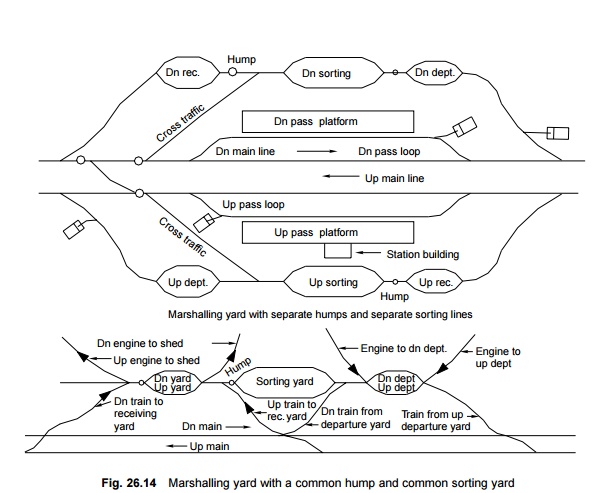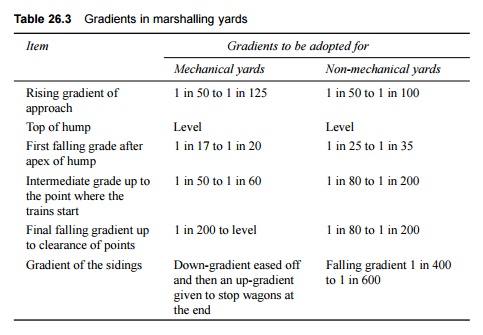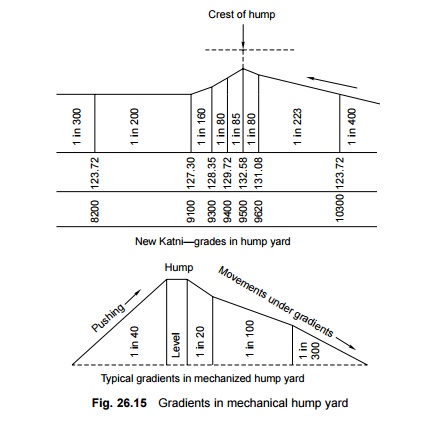Chapter: Civil : Railway Airport Harbour Engineering : Railway Engineering : Railway Stations and Yards
Types of Railway Yards

Types of Yards
A yard is a system of tracks laid
out to deal with the passenger as well as goods traffic being handled by the
railways. This includes receipt and dispatch of trains apart from stabling,
sorting, marshalling, and other such functions. Yards are normally classified
into the following categories.
Coaching yard
The main function of a coaching
yard is to deal with the reception and dispatch of passenger trains. Depending
upon the volume of traffic, this yard provides facilities such as watering and
fuelling of engines, washing of rakes, examination of coaches, charging of
batteries, and trans-shipment of passengers.
Goods yard
A goods yard provides facilities
for the reception, stabling, loading, unloading, and dispatch of goods wagons.
Most goods yards deal with a full train load of wagons. No sorting,
marshalling, and reforming is done at goods yards except in the case of 'sick'
wagons or a few wagons booked for that particular station. Separate goods
sidings are provided with the platforms for the loading and unloading of the
goods being handled at that station.
Marshalling yard
A goods yard which deals with the
sorting of goods wagons to form new goods trains is called a marshalling yard.
This is discussed in detail in Section 26.8.1.
Locomotive yard
This is the yard which houses the
locomotive. Facilities for watering, fuelling, examining locomotives,
repairing, etc., are provided in this yard. The yard layout is designed
depending upon the number of locomotives required to be housed in the
locomotive shed. The facilities are so arranged that a requisite number of
locomotives are serviced simultaneously and are readily available for hauling
the trains. Such yards should have adequate space for storing fuel. The water
supply should be adequate for washing the locomotives and servicing them.
Sick line yard
Whenever a wagon or coach becomes
defective, it is marked 'sick' and taken to sick lines. This yard deals with
such sick wagons. Adequate facilities are provided for the repair of coaches
and wagons, which include examination pits, crane arrangements, train
examiner's office and workshop, etc. A good stock of spare parts should also be
available with the TXR (train examiner) for repairing defective rolling stock.
1
Marshalling Yard
The
marshalling yard (Fig. 26.14) is a yard where goods trains are received and
sorted out, and new trains are formed and finally dispatched to various
destinations.

This yard receives loaded as well
as empty goods wagons from different stations for further booking to different
destinations. These wagons are separated, sorted out, properly marshalled, and
finally dispatched bearing full trainloads to various destinations. The
marshalling of trains is so done that the wagons can be conveniently detached
without much shunting en route at wayside stations.
Functions
A marshalling yard serves the
following functions at the specified locations within the yard itself.
Reception of trains Trains
are received in the reception yards with the help of various lines.
Sorting of trains Trains
are normally sorted with the help of a hump with a shunting neck and
sorting sidings.
Departure of trains Trains
depart from departure yards where various lines are provided for this
very purpose. Separate yards may be provided to deal with up and down traffic
as well as through trains, which need not be sorted out.
Principles of design
A marshalling yard should be so
designed that there is minimum detention of wagons in the yard and as such
sorting can be done as quickly as possible. These yards should be provided with
the necessary facilities such as a long shunting neck, properly designed hump,
braking arrangement in the shape of mechanical retarders, etc., depending upon
the volume of traffic. The following points should be kept in mind when
designing a marshalling yard.
(a) Through
traffic should be received and dispatched as expeditiously as possible. Any
idle time should be avoided.
(b) There
should be a unidirectional movement of the wagons as far as possible.
(c) There
should be no conflicting movement of wagons and engines in the various parts of
the yard.
(d) The leads
that permit the movement of wagons and train engines should be kept as short as
possible.
(e) The
marshalling yard should be well lighted.
(f) There
should be adequate scope for the further expansion of the marshalling yard.
Types
Marshalling yards can be
classified into three main categories, namely, flat yards, gravitation yards,
and hump yards. This classification is based on the method of shunting used in
the marshalling yard.
Flat yard In this
type of yard, all the tracks are laid almost level and the wagons are
relocated for sorting, etc., with the help of an engine. This method is costly,
as it involves frequent shunting, which requires the constant use of locomotive
power. The time required is also more as the engine has to traverse the same
distance twice, first to carry the wagons to the place where they are to be
sorted and then to return idle to the yard. This arrangement, therefore, is
adopted when
(a) there is
limitation of space,
(b) there is
a severe limitation of funds, or
(c) the number
of wagons dealt with by the marshalling yard is very low.
Gravitation yard In this
yard, the level of the natural ground is such that it is possible to lay
some tracks at a gradient. The tracks are so laid that the wagons move to the
siding assigned for the purpose of sorting by the action of gravity. Sometimes,
shunting is done with the help of gravity assisted by engine power. However, it
is very seldom that natural ground levels are so well suited for gravitation
yards.
Hump yard In this
yard, an artificial hump is created by means of proper earthwork. The
wagons are pushed up to the summit of the hump with the help of an engine from
where they slide down and reach the sidings under the effect of gravity. A hump
yard, therefore, can be said to be a gravitation yard as shunting is done under
the effect of gravity. The gradients normally adopted in this regard are listed
in Table 26.3. These are, however, only recommended gradients and the final
gradient for a particular yard is decided after a test run of the trains over
the humps, taking into consideration the rolling quality of different types of
wagons and the spacing between successive groups of wagons. The topography of
the location of the yard also plays an important role in deciding the gradient.
Table
26.3 Gradients in
marshalling yards

Regulation
of speeds in hump yards The speed of the wagons is regulated to ensure
that they are kept in a stable condition in the siding where they are to be
sorted, so that there is least damage to them. The regulation of speed is done
as follows.
Mechanical
method In this method, wagons are slowed down
automatically with the help of 'retarders' (Fig. 26.15).
Retarders' normally in the shape of bars fixed on either side of the track, operate
electrically or electromechanically and offer resistance to the movement of
wagons by pressing against the sides of the moving wheels. This finally stops
the wagons at the appropriate place. Such mechanical retarders are used
extensively in Germany and on other developed railways.

Non-mechanical yard In a
non-mechanical yard, the speed of the wagon is regulated manually
with the help of hand brakes or skids. A shunting porter runs alongside the
wagons and applies a hand brake to the wagon at an appropriate place, making
the wagon slip and stop. Skids are also used to slow down the wagons. Skids are
placed on the track; they get dragged by the rolling wagon and the friction
thus developed reduces the speed of the wagon and stops it at the desired
location.
Design of various constituents
The design details of the various
components of a marshalling yard are discussed below.
Spacing
of marshalling yards This depends upon the average distance that a long-distance
train can go. If the lead is 500 km and the section train can go up to 100 km,
the approved spacing of a marshalling yard is 400 km.
Siting of marshalling yard A
marshalling yard is normally sited at a junction point, a depot yard to
a group of collieries, a feeder yard for a big terminal point, or a steel
plant, etc.
Reception yard The
number of lines to be included in a reception yard depends upon the
number of trains to be received and on the frequency of their arrival. Normally
one reception line is provided for every three to four trains. The approved
length of a siding is normally 700 m for BG and 650 m for MG.
Shunting neck The
length of the shunting neck should be longer than the longest train.
Hump The hump
should be designed to meet the following objectives.
(a) It should
be such that even the wagon whose movements are affected the worst by the most
adverse weather conditions can clear the fouling mark, when sent to the
outermost siding.
(b) It should
be such that a successive group of wagons are separated from each other to the
extent that it enables the point between them to be operated upon so that the
wagons can be sent to various sidings.
(c) The hump
should be such that the speed of the wagons is so regulated that there is no
damage to the wagons when they bump against each other in the sorting lines.
The figures given in Table 26.4 can be taken as a rough guide for choosing the
design of the humps.
Table
26.4 Design of humps

Sorting yard The
number of lines to be included in the sorting yard depends upon the
number of destinations for which the trains are to be assembled. The length of
each sorting line is about 15 to 20% more than that of a normal train so that
there is provision of some space behind the wagons. The layout of the sorting
yard may be of the ladder or the balloon type. The speed of the wagons is
controlled by hand brakes while the skids and the mechanical retarders are
controlled by manual and mechanical means, respectively.
Departure
yard The number of lines to be included in a departure yard depends
upon the number of trains proposed to be dispatched from the yard and on
the frequency of their departure. Some engineers feel that there is no need for
a separate dispatching yard because it unnecessarily increases the length of the
marshalling yard. According to them, trains should be dispatched straight from
the sorting lines. This arrangement, however, runs into problems if the
departure of the trains is delayed on account of operational reasons.
The pattern of transportation of
goods traffic has changed drastically in the recent past. Now, most goods
traffic is carried as trainloads from point to point. The loading of piecemeal
wagons has also been drastically reduced. Consequently, the need and importance
of goods marshalling yards has reduced considerably.
Related Topics